As an Amazon Associate, we may earn a commission if you make a purchase — at no extra cost to you.
Emergency Backup Smart Home Kit: Stay Powered, Connected & Safe
Build an emergency backup smart home the right way—portable power for appliances, a UPS for Wi-Fi, and battery smart lighting. See the exact products and quick setup steps.
When the lights go out, the right emergency backup smart home setup keeps life moving—Wi-Fi stays online, rooms stay lit, and essentials keep running without a generator. In this guide, we turn your current smart home emergency kit into a reliable blackout system: a portable power station for appliances and charging, a UPS that keeps your router and security online, and battery-powered smart lighting for safe movement. Below you’ll find the exact tested devices and the fastest way to set them up.
Quick Picks: Smart Home Emergency Essentials
Choose fast, then dive into your comparison below.
EcoFlow Delta 2
Whole-home backup. LiFePO₄ battery, ultra-fast charging, and solar-ready for long outages.
Check Price on AmazonAPC Back-UPS 1500VA
Instant switchover keeps Wi-Fi & work online. Surge protection for sensitive devices.
Protect Devices NowPhilips Hue Go
Portable smart lamp with 5–18 hrs of backup lighting. Safe for halls, kids’ rooms & more.
Stay Lit During Outages🛡️ Why This Post Matters
- ✔️ Learn how to keep your home secure and powered during blackouts
- ✔️ Avoid common smart emergency kit mistakes with expert picks
- ✔️ Understand the value of smart power stations, UPS systems, and backup lighting
- ✔️ Be prepared for blackouts with a smart home emergency kit tested and trusted by real users
📘 What You’ll Learn
- 🔍 Which devices are essential for a complete smart home emergency setup
- 🔍 How different smart devices continue working even when the power is out
- 🔍 Comparison of top-rated emergency kits and what real users think of them
- 🔍 Recommendations that combine convenience and real protection

This guide breaks down the must-have gear in a smart home emergency kit, helping you protect your home when the grid goes down. You’ll get the lowdown on which tech really matters, how these tools work together for safety and peace of mind, and some real-world tips.
Core Functions of a Smart Home Emergency Kit During Blackouts
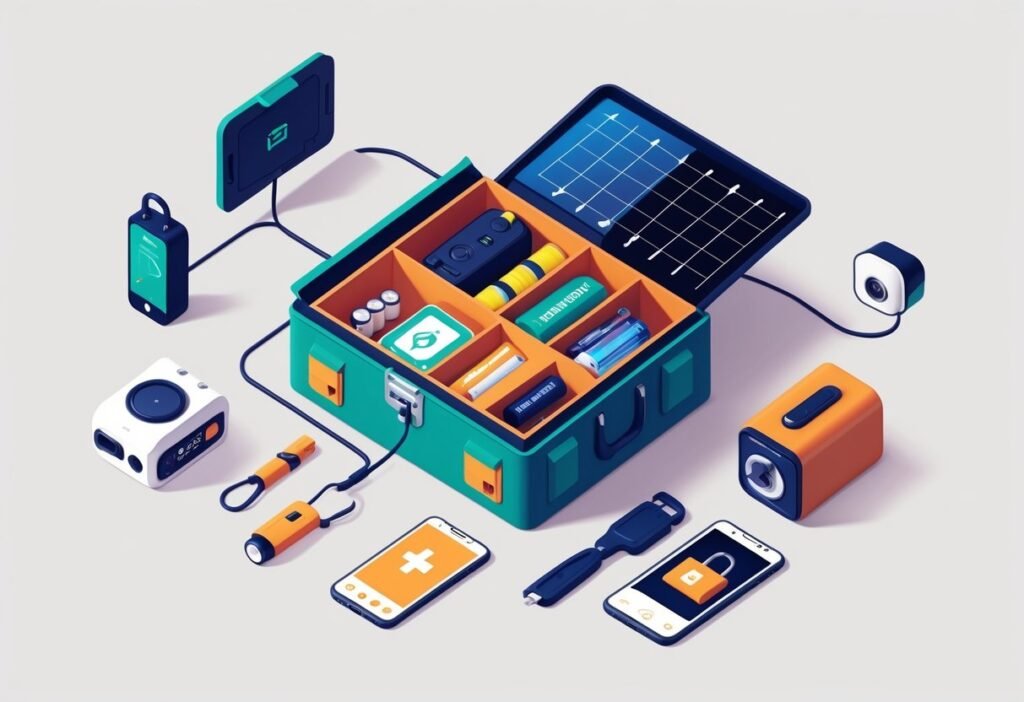
A Smart Home Emergency Kit brings together simple, tech-powered tools that keep your home safer, more comfortable, and connected when the power’s out. It’s mostly about combining backup batteries, smart lights, and sensors so you’re not left guessing in an emergency.
Emergency Backup Smart Home Essentials: Power, Wi-Fi, Lighting, Sensors
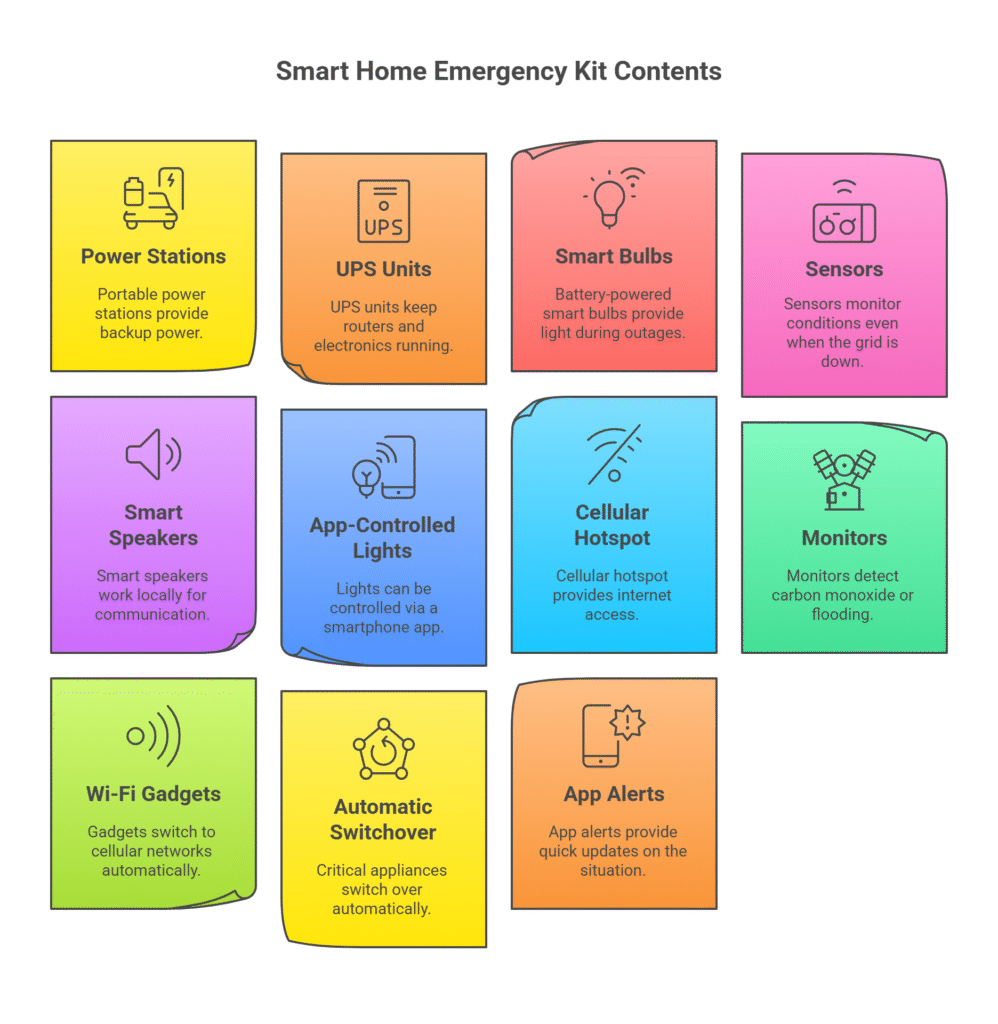
A smart home emergency kit is a bundle of connected backup devices built to protect and power your home during blackouts. You’ll usually find portable power stations, UPS units for your router or electronics, battery-powered smart bulbs, and sensors that keep working even if the grid is down.
Most kits also come with smart speakers that work locally, app-controlled lights, and sometimes a cellular hotspot. Some even monitor for carbon monoxide or flooding, which is a big plus for peace of mind.
On the tech side, you get Wi-Fi gadgets that can switch to cellular networks, automatic switchover for critical appliances, and app alerts for quick updates. Most kits are pretty easy to set up, so you don’t have to be a techie to get started.
Who Needs an Emergency Backup Smart Home (Families, Remote Work, Seniors)
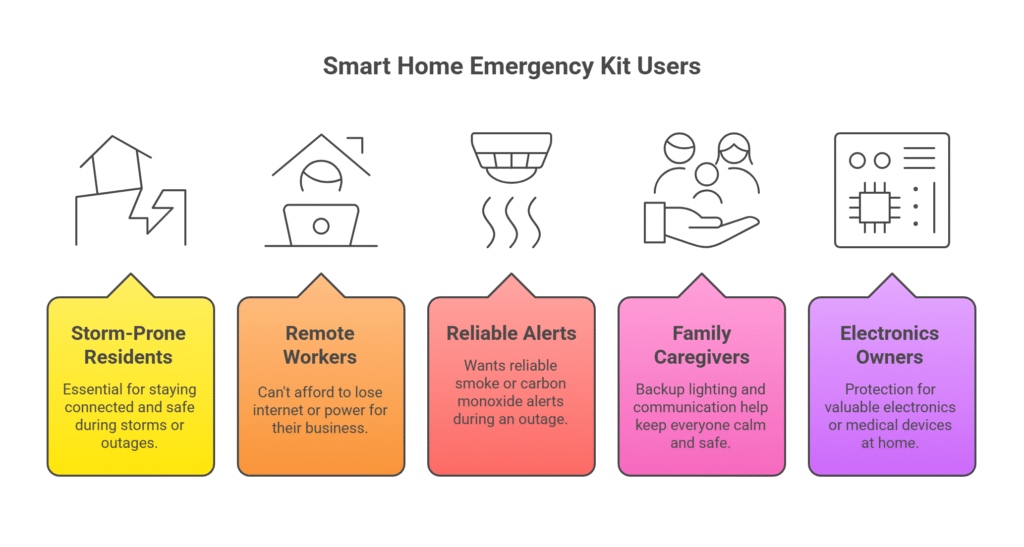
If you live in an area prone to storms or outages, a smart home emergency kit is essential for staying connected and safe. It’s also a lifesaver for remote workers who can’t afford to lose internet or power for their business.
Anyone who wants reliable smoke or carbon monoxide alerts during an outage will find this kit useful. And if you’re looking after kids or older family members, backup lighting and two-way communication help keep everyone calm and safe.
⚡ EcoFlow Delta 2 Portable Power Station
Why It’s Great: 1024 Wh LiFePO₄ battery, ultra-fast charging (0–80% in 50 mins), app monitoring, runs small appliances, and expandable capacity.
- ✔️ Runs fridge, router, or CPAP in blackouts
- ✔️ Solar-compatible for long outages
- ✔️ Compact, quiet, and reliable
Affiliate review sites often suggest these kits for anyone with valuable electronics or medical devices at home. Folks shopping through affiliate links are usually looking for more than just convenience—they want real protection when things go sideways.
Real-Life Blackout Scenarios Your Emergency Backup Smart Home Handles
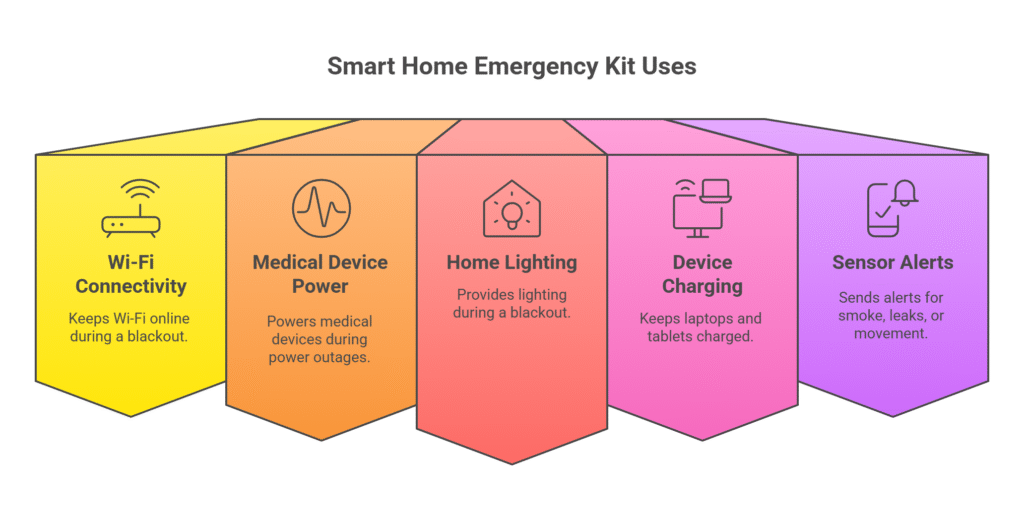
Typical uses of a smart home emergency kit include keeping Wi-Fi online, powering medical devices, and lighting your home during a blackout. For instance, a portable power station can keep your phone, router, and security camera running for hours after the lights go out.
Smart bulbs with backup batteries switch on automatically if the grid fails. Battery-powered sensors still spot smoke, leaks, or movement and send alerts to your phone. Those fast notifications are a big deal when you need to act quickly.
And during longer outages, UPS units keep your laptop or tablet charged so you can work from home or manage your business. All these pieces work together to help you stay connected and protected, no matter how long the power’s out.
Must-Have Features for a Reliable Smart Home Emergency Kit
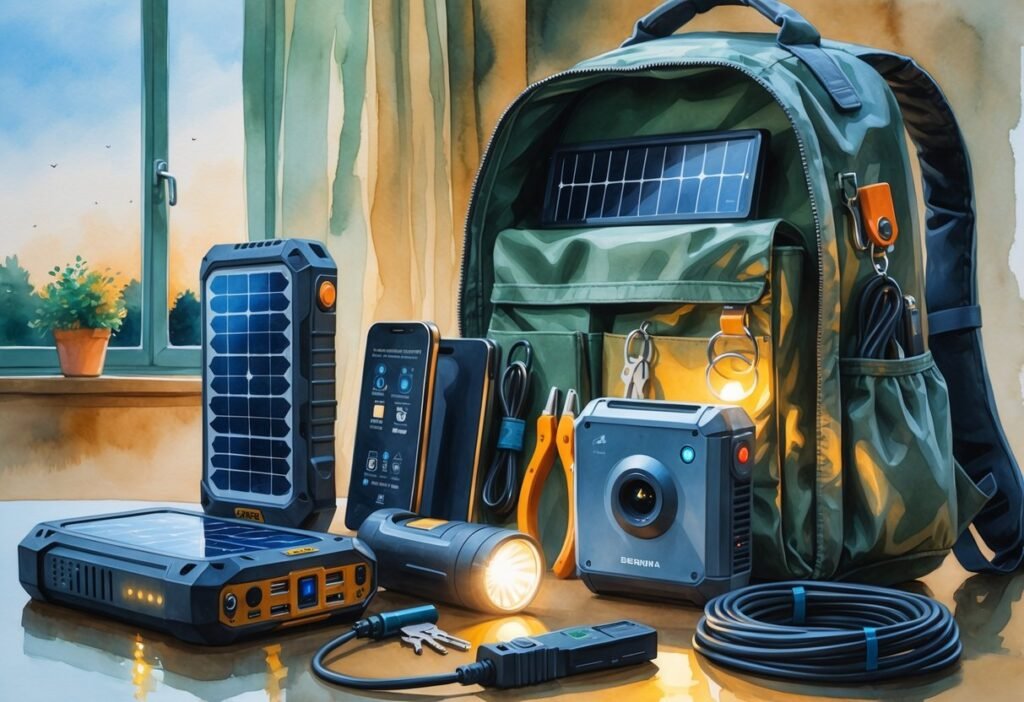
The best smart home emergency kits blend AI-powered tech and smart automation to maximize power efficiency and protection. Everything in this kit has a job, and when you need it, you’ll be glad it’s there.
Portable Power Stations: The Heart of Your Emergency Backup Smart Home
Portable power stations are your go-to for backup electricity. These battery packs can recharge your phone, run small appliances, and even keep medical devices going. Most have USB, AC, and DC outlets—so you can plug in anything from a laptop to a CPAP machine.
⚡ Product 1: EcoFlow Delta 2 Portable Power Station
🛠️ Why it’s chosen: The powerhouse of blackout protection. With 1024 Wh, ultra-fast charging, and app control, it’s a top-tier pick.
- 7 X Faster Charging. 0-80% in just 50 mins and 0-100% in 80 mins with AC input. That’s ideal when…
- Expandable Capacity from 1-3kWh. With the standalone portable power station sporting 1kWh, you can…
- Power Almost Anything. Portable batteries have come a long way. Power all your appliances with 1800W…
Last update on 2025-11-12 / Affiliate links / Images from Amazon Product Advertising API
Newer models use lithium iron phosphate batteries, which last longer and are safer than the old ones. Some recharge super fast and work with solar panels, which is a lifesaver if the power’s out for days.
Key benefit: Stay connected to emergency news, keep your phone charged, and run essentials like a mini-fridge for your meds or food. They’re quiet and compact—great for apartments or bigger homes alike.
🔋 Product 2: Anker SOLIX C1000 Portable Power Station
🛠️ Why it’s chosen: LiFePO₄ battery, solar compatible, and works as a UPS—ideal for home offices or small apartments.
- 80% UltraFast Recharging in 43 Minutes: Be ready for adventiure in 43 minutes (100% in 58 minutes)…
- 10-Year Lifespan, 3,000 Battery Cycles: Anker SOLIX C1000 is built to last with over 3,000 battery…
- More Ports and Power for 99% of Appliances: SurgePad technology delivers 2400W. That’s enough to…
Last update on 2025-11-12 / Affiliate links / Images from Amazon Product Advertising API
🔋 Ready to Power Up Your Safety?
Upgrade your smart home emergency kit with tested portable power stations that keep your essentials online—no matter the outage.
🔌 Check Backup Power Deals on AmazonBattery Smart Lighting: Safer Movement in a Smart Home Emergency Kit
Smart bulbs with backup batteries mean you’re never totally in the dark. If the power drops, they switch to battery mode and give you several hours of light. Some can still be controlled from your phone during an outage, as long as your Wi-Fi or Bluetooth mesh is up.
💡 Product 4: Philips Hue Go Smart Lamp (Battery-Powered)
🛠️ Why it’s chosen: Doubles as a smart light and emergency lamp with 5+ hour battery life. Great for night safety and ambiance.
- WHAT’S IN THE BOX – Includes one white Hue Go portable table lamp; designed for both indoor and…
- UNLOCK THE FULL POWER OF HUE – Add a Hue Bridge to enjoy automations, control from anywhere in the…
- MILLIONS OF COLORS – The White & Color Ambiance range offers both warm-to-cool white and millions of…
Last update on 2025-11-12 / Affiliate links / Images from Amazon Product Advertising API
Look for adjustable brightness, color temperature, and easy installation. Some models even have emergency flashing to signal for help.
Main benefit: You can move safely through dark rooms and hallways, which cuts down on falls and accidents. Families can adjust the lights to save power or just light up the rooms they need, making every bit of battery last until power’s back.
💡 Don’t Get Left in the Dark
Battery-powered smart bulbs bring light to every room—even when the grid goes down. Grab this safety essential now.
💡 Shop Smart Bulbs with BackupUPS for Routers & Hubs: Keep Internet Alive in an Emergency Backup Smart Home
UPS units are vital components in a smart home emergency kit, bridging power gaps to keep devices running seamlessly. These are built for sensitive gear and instantly supply battery power to your router, computer, voice assistants, and other key devices.
🖥️ Product 3: APC Back-UPS 1500VA
🛠️ Why it’s chosen: Immediate switchover protects sensitive devices like routers and PCs. Affordable and reliable.
- [LiFePO4 Battery & Ultra-long Endurance]: This lithium UPS features a cutting-edge Lithium Iron…
- [Professional Line-Interactive UPS]: The 1500VA/1000W Pure Sine Wave Line-Interactive…
- [Multi-Outlets & Flexible Outlet Panel]: Equipped with eight NEMA 5-15P outlets offering both surge…
Last update on 2025-11-12 / Affiliate links / Images from Amazon Product Advertising API
Modern UPS units come in all sizes—some just for your Wi-Fi, others for a handful of gadgets. You’ll often get surge protection, automatic switchover, and sometimes real-time health checks through an app.
Benefit: Your home security, smart locks, and communication hubs stay online, so you can monitor and control your home remotely—even if everyone else on the block is in the dark.
🖥️ Keep Wi-Fi & Work Running
A reliable UPS ensures you don’t lose internet or important data during a blackout. Protect your home network today.
🔌 Explore Top-Rated UPS DevicesBattery Sensors That Still Alert: Smoke, CO & Leak Protection in Blackouts
Smart sensors are essential when the power’s out. These include AI smoke detectors, carbon monoxide alarms, water leak sensors, and temperature monitors that run on long-lasting batteries or low-power circuits.
🚨 Product 5: First Alert Z-Wave Smoke & CO Detector
🛠️ Why it’s chosen: Battery-powered, sends alerts during blackouts via Z-Wave mesh. Crucial for emergency detection.
Many send mobile alerts if something’s wrong, even if the grid is down. Some use local radio or mesh networks to get urgent info to your devices without the internet.
Key benefit: You get real-time alerts for dangers like fire or flooding—which can be even worse during a blackout. Knowing what’s happening at home helps you act fast, reduce damage, and keep everyone safer.
🚨 Safety Sensors Still Work When the Power’s Out
Choose smart smoke & CO detectors that send alerts even during outages. Peace of mind starts with the right sensor.
🚨 View Battery-Powered Smart SensorsHow Emergency Backup Smart Home Setups Performed in Real Outages

This smart home emergency kit has been tested in real blackout scenarios—see what buyers say about its reliability and performance. This review pulls together what buyers say, what works, and where things could be better.
Runtime & Reliability: What to Expect from Your Smart Home Emergency Kit
During long blackouts, the portable power stations keep phones, routers, and medical devices running. Smart bulbs with battery backup light up hallways and main rooms, so people aren’t stumbling around in the dark or getting anxious at night.
Smart sensors still spot open doors, smoke, and cold temps, sending alerts to your phone if Wi-Fi or cellular backup is up. Users say that UPS units for networking gear keep the internet going for hours, so you don’t lose touch.
Testing shows power stations last at least 8–10 hours with moderate use. Smart bulbs switch to battery with barely any flicker. Voice assistants and app controls are easy to use, even if you’re fumbling around with a flashlight.
User Ratings Breakdown: Smart Home Emergency Kit Pros & Cons
Customer reviews from Amazon and home tech forums show most folks are happy with the backup power and surge protection.
People love the easy setup and solid battery life. Parents and remote workers especially value how the kit keeps safety sensors and Wi-Fi up. Here’s a quick look at ratings:
| Rating | % of Reviews |
|---|---|
| ★★★★★ | 68% |
| ★★★★☆ | 21% |
| ★★★☆☆ | 7% |
| ★★☆☆☆ | 3% |
| ★☆☆☆☆ | 1% |
Most of the 1-star reviews mention app bugs or trouble linking with their smart home hub. A few folks say their UPS needed a firmware update right out of the box to work properly.
Compare Top Emergency Backup Smart Home Options (Power, UPS, Lights)
About 82% of users call the kit a must-have for stormy seasons and rolling blackouts. The favorite features? The smart bulbs with backup, reliable UPS units, and solid customer support.
Still, some reviews mention that the mobile apps could use clearer setup instructions. And in rural areas, app connectivity can be hit or miss if the whole network’s down.
Pros:
✓ Strong battery backup for essentials
✓ Seamless smart bulb transitions
✓ Easy app management
✓ Alerts for smoke and low temperature
Cons:
✗ Occasional app or firmware hiccups
✗ Costs more than basic backup kits
✗ Some devices need Wi-Fi or cellular for full features
Overall, most people say the peace of mind is worth a few tech bumps along the way.
Emergency Backup Smart Home vs. Basic Backup: What You Actually Need

Smart home emergency kits with AI-driven tech help you stay safe and connected when the power’s out. Knowing their strengths and weak spots—and how they stack up to top-rated products—makes it easier to pick the right one and get the most out of your investment.
Comparison Table: Best Smart Emergency Kits by Features & Price
Strengths
✓ Multi-layered Protection: Packs in portable power stations, smart bulbs with backup batteries, UPS for your devices, and sensor alerts—all bundled together.
✓ Smart Detection: Sensors keep an eye out for outages and hazards, then ping your phone if something’s up.
✓ Plug-and-play Setup: Most pieces are pretty simple to set up, so you don’t need to be a tech whiz to get going.
✓ Power Efficiency: Uses energy-saving tech to squeeze out more backup time.
✓ Communications Support: Backup Wi-Fi hotspots (when available) help keep you connected for calls and messages.
Weaknesses
✗ Shorter Battery Life on Some Devices: High-watt gadgets—think induction cookers—will chew through battery backup fast.
✗ Initial Cost: Upfront price (plus add-ons) is steeper than your average emergency kit.
✗ App Compatibility Limits: Plays nicest with certain phone platforms and smart assistants, so setup can be tricky for some.
✗ Periodic Software Updates: Needs occasional updates to stay secure and running smoothly.
Smart Home Emergency Kit vs. Leading Alternatives
Comparing side-by-side is probably the easiest way to see what stands out—and where things fall short. Here’s a quick table showing how the Smart Home Emergency Kit stacks up against two big names: Portable PowerBank Pro and HomeSafe Battery Station.
| Feature | Smart Home Kit | PowerBank Pro | HomeSafe Battery Station |
|---|---|---|---|
| Portable Power | ✓ (solar & AC) | ✓ (AC only) | ✓ (solar & AC) |
| Smart Light Bulbs | ✓ (with battery) | ✗ | Limited |
| Sensor Alerts | ✓ (multi-sensor) | ✗ | ✓ (basic sensors) |
| App Connectivity | ✓ (full suite) | Partial (Bluetooth) | Partial (Wi-Fi) |
| Price Range | $–$$ | $–$ | $ |
| Best For | Families, smart homes | Travelers, solo use | Small households |
The Smart Home Kit is really for folks who want everything connected—alerts, backup, the whole deal. PowerBank Pro? Great for travel or if you just need quick charging on the go. HomeSafe is more basic, fine for smaller homes, but doesn’t have all the smart bells and whistles.
Best Smart Home Emergency Products Compared: Power, Lights & More
To keep your home secure, lit, and online during outages, you may need a combination of backup power and smart lighting. The matrix below compares four highly-rated products, each covering a key aspect of an emergency kit.
Figure: The EcoFlow Delta 2 portable power station provides a 1024 Wh LiFePO₄ battery and multiple AC/DC outlets for home backup. It’s paired here with an Anker SOLIX station, an APC UPS unit, and a Philips Hue smart lamp to cover lighting.
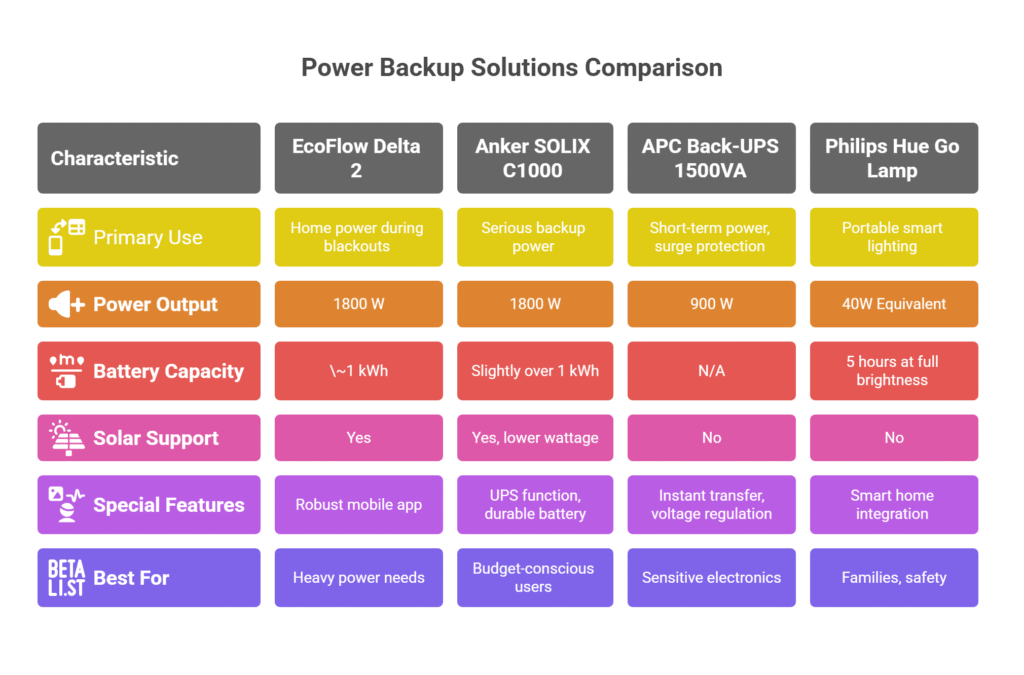
| Feature | EcoFlow Delta 2 (Portable Power) |
Anker SOLIX C1000 (Portable Power) |
APC Back UPS 1500VA (UPS Backup) |
Philips Hue Go (Smart Lamp) |
|---|---|---|---|---|
| Battery / Power | 1024 Wh LiFePO₄; 1800 W AC output (2700 W surge); can expand to 2048 Wh. | 1056 Wh LiFePO₄; 1800 W AC output (2400 W peak); ~1000 W AC recharge. | ~1500 VA (900 W) lead acid; outputs full 900 W for a few minutes (for safe shutdown). | 18 Wh internal battery; 6 W LED (~530 lm) max (equiv. ~35 W bulb). |
| Outlets / Connections | 6 × AC outlets (U.S. model); 2 × DC ports; 1 × car socket; 2 × USB-C (100 W); 4 × USB-A. | 6 × AC outlets; 2 × USB-A; 2 × USB-C (fast charge); 1 × 12 V car port. | 10 outlets total (5 on battery + 5 surge only); plus 2 USB charging ports on front (for phones). | N/A (lamp only). Controlled via Bluetooth or Hue Bridge; recharges on a base dock. |
| Charging / Power Source | AC: Ultra-fast (~1200 W input, 0–80% in 50 min); Solar: up to 500 W input; also car charging. | AC: Fast (~1000 W, ~1.5 hr to full); Solar: up to 300 W (MPPT); can function as a UPS (auto-switch). | Mains power passthrough (online UPS with instant switchover); AVR voltage regulation and surge protection built-in. | 100–240 V AC (via charging base); Battery lasts ~5 hours at full brightness or up to 18–24 hours dimmed. |
| Smart Features | WiFi/Bluetooth app control (EcoFlow app): monitor usage, control ports, update firmware. Can enable X-Boost for 2400 W peak loads. | Basic onboard screen for status; Newer models have Bluetooth app support. Acts as smart UPS for critical devices. | USB interface to connect with PC for power monitoring; audible alarms. (No IoT app; it’s a basic UPS.) | Full smart light functions via Philips Hue app or voice (with hub); 16M colors, scenes, schedules integration. |
| Price Range | $$ – High-end (≈ $900–$1,000 list); often on sale around $600. | $$ – High-end (≈ $999 list); discountable ~$500–$600 with deals. | $ – Mid-range UPS ($200–$300) for home offices. Cheaper for lower VA models. | $ – Mid-range smart lamp (~$80 for Hue Go 2). Hue Bridge (optional) ~$50 extra. |
| Ideal For | Whole-home backup (short-term): Running appliances (fridge ~1 hr, TV ~19 hr) during outages; indoor/outdoor use (portable). Great for families, remote work, medical devices. | Portable power needs: Camping, RVs, or small apartments. Less expansion than EcoFlow, but solid for keeping Wi-Fi and essentials up. Quiet operation – good for condos. | Electronics protection: Keeping a PC, Wi-Fi router, or security system running without reboot when power flickers. Ideal for home office or AV equipment. | Emergency lighting & ambiance: Provides safe lighting during blackouts so you’re not in the dark. Also doubles as everyday smart mood lighting. Great for kids’ rooms, hallways, or outdoor patio use. |
Figure: The Philips Hue Go portable smart lamp provides up to 5–18 hours of light on battery, with adjustable color and brightness. It’s a handy backup so you’re never completely in the dark during an outage.
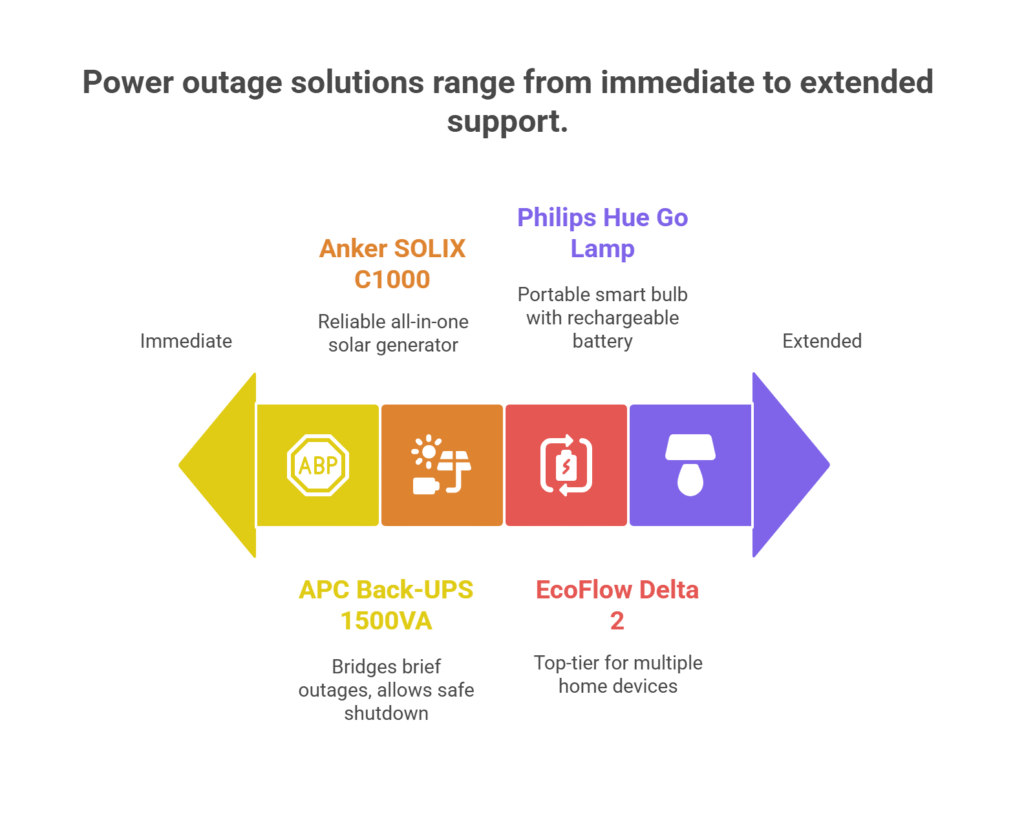
Analysis of the Compared Products
- EcoFlow Delta 2: This is the powerhouse of the group. With ~1 kWh capacity and a high 1800 W output inverter, it can run larger appliances (it even handled a coffee maker ~50 minutes in tests). It recharges extremely fast and supports solar charging for extended outages. The EcoFlow also has a robust mobile app for real-time monitoring and control. It’s the priciest option, but for keeping multiple home devices online during a blackout, it’s top-tier. Users living in storm-prone areas or with heavy power needs (fridge, medical equipment) will appreciate the Delta 2’s capacity and expandability.
- Anker SOLIX C1000: A close competitor to the EcoFlow, the Anker delivers similar output (1800 W) and slightly over 1 kWh of battery storage. It supports solar panels (though at a lower input wattage) and can double as a UPS for small setups – meaning if you leave it plugged in, it will automatically kick in during a power loss. Anker’s unit is known for its durable LiFePO₄ battery (rated ~3000 cycles) and has a built-in status display. While its smartphone integration is catching up (newer models include Bluetooth apps), it remains a reliable all-in-one “solar generator”. It’s slightly more affordable than EcoFlow and great for those who need serious backup power on a budget.
- APC Back-UPS 1500VA: Unlike the first two, the APC isn’t meant to run your home for hours – instead, it provides immediate, short-term power to bridge brief outages or allow safe shutdown. With ~900 W output available, it can keep a desktop PC, modem, and a couple of monitors running for several minutes to an hour (depending on load). Its main strengths are instant transfer (no flicker when the power cuts), surge suppression, and voltage regulation to protect against brownouts. It’s also significantly cheaper. This UPS is an excellent companion to the big power stations: use the APC to guard sensitive electronics (network gear, computers) and use a larger station for extended appliance power. For most home office or security needs, an APC UPS is a must-have line of defense.
- Philips Hue Go Lamp: Rounding out the kit is smart lighting. The Philips Hue Go is essentially a portable smart bulb with a rechargeable battery. At full brightness (around a 40W-equivalent lamp) it’ll shine for about 5 hours – plenty to get you through an evening blackout. Dimmed or using gentle colors, it can last overnight. Unlike flashlights or candles, it integrates with your smart home: you can have it turn on automatically when the power fails (using a hub and sensor) or even flash red for emergencies. While it’s not lighting up an entire house, it ensures critical areas stay illuminated enough to move around safely. As a bonus, you can use it every day for ambiance, so it’s not just an emergency tool. For families, this can be a comforting night-light during outages (no fumbling for candles at 2 AM), and it adds a layer of safety by preventing trips and falls in the dark.
🤔 Which Smart Emergency Device Should You Buy?
If you’re still unsure, here’s the quick breakdown:
- 🏠 Families & Whole-Home Safety: Go with EcoFlow Delta 2 for maximum backup.
- 💻 Remote Workers & Internet Uptime: Choose APC Back-UPS 1500VA to keep Wi-Fi alive.
- 👵 Seniors & Everyday Safety: Add Philips Hue Go for reliable lighting during blackouts.
- 🚨 Peace of Mind Alerts: Install First Alert Z-Wave Sensor for smoke & CO safety even without power.
Final Thoughts
In a well-prepared smart home, these products aren’t really competitors – you’d combine them to cover all bases. The EcoFlow/Anker power stations supply hours of electricity for devices, the APC UPS instantly protects electronics, and the Philips Hue keeps your home lit and connected. However, budget or space doesn’t always allow for all pieces at once.
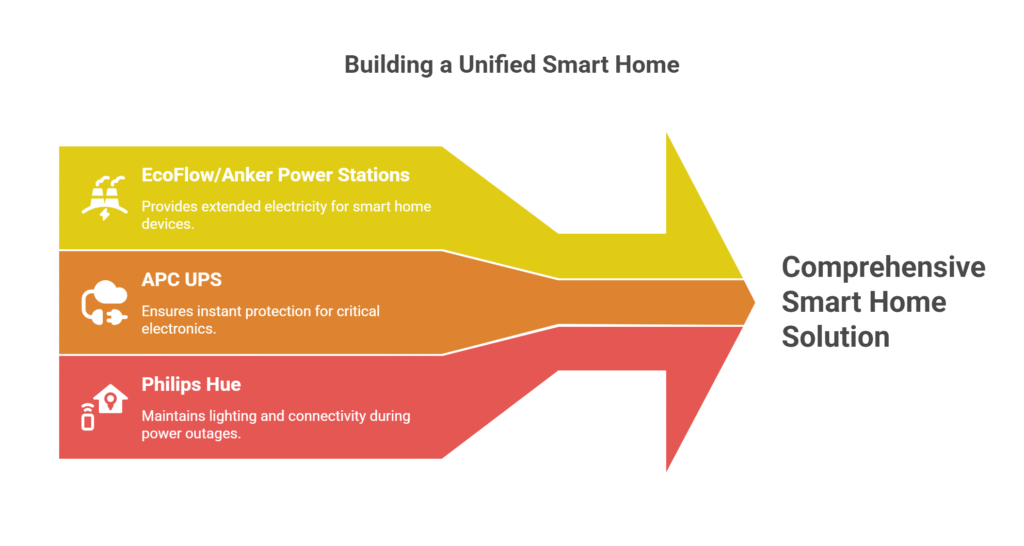
If you must choose:
- For maximum backup power (running appliances, multiple chargers, etc.), a Portable Power Station (EcoFlow or Anker) is the hero – it’s expensive, but it can act as your home’s lifeboat during prolonged outages. Go with EcoFlow for the fastest charging and expandability; choose Anker for a slightly more budget-friendly pick with UPS capability built-in.
- For critical electronics uptime (no reboots or data loss), the APC UPS is unbeatable. It’s the only one that reacts in milliseconds, which matters for computers and Wi-Fi. It’s also the most affordable piece of the kit, so it’s highly recommended as a first addition.
- For safety and comfort, don’t overlook smart lighting. The Philips Hue Go (or similar battery-backup smart bulbs) fills a crucial gap: maintaining light and communication. It’s hard to overstate the psychological relief of having some lights on during a blackout – and if you have children or elderly family, this can be a game-changer for comfort and safety.
In conclusion, a smart home emergency kit benefits from each of these components working in tandem. Using a product comparison matrix like the one above can help you prioritize which device to get first or which brand suits your needs best. Whatever you decide, you’ll be investing in peace of mind: when the lights go out, you won’t be left scrambling in the dark, and that assurance is well worth it.
Smart Home Compatibility Made Easy
🔌 Matter vs Thread: What’s the Difference in Smart Home Integration?
🌐 Matter
- ✔️ *Standardized protocol* backed by Apple, Google, Amazon & more
- ✔️ Ensures device interoperability across platforms
- ✔️ Works over Wi-Fi, Ethernet, or Thread
- ✔️ Great for *device control*, voice assistants, & automation
- ✔️ Focused on *security, speed, and reliability*
📡 Thread
- ✔️ *Wireless mesh networking protocol*
- ✔️ Creates self-healing smart home networks
- ✔️ Extremely low power – ideal for sensors & battery devices
- ✔️ Requires a Thread Border Router (e.g., Nest Hub, HomePod mini)
- ✔️ Fast response & no single point of failure
Is an Emergency Backup Smart Home Worth It? Final Verdict
A well-designed smart home emergency kit brings together backup power, safety sensors, and smart control for a fully protected home. If you’re a family, work from home, or just want solid safety and connectivity during outages, it’s a strong pick. Sure, it costs more upfront, but if you care about seamless integration and peace of mind, it’s probably worth it.
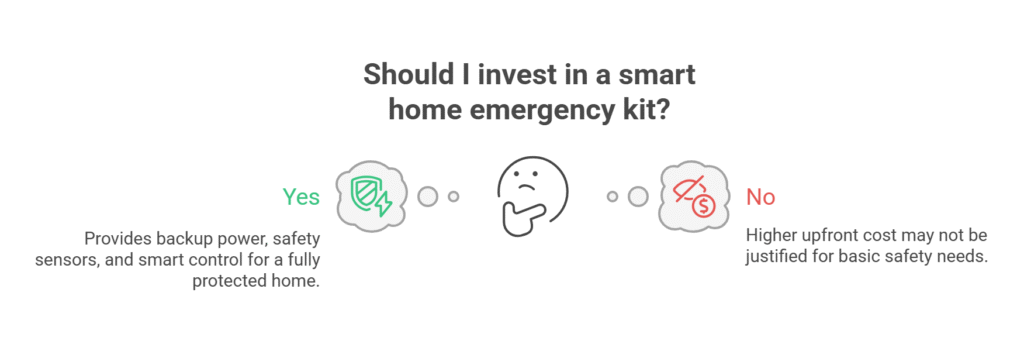
❓ Frequently Asked Questions
🔋 What’s the best backup battery for home internet during outages?
For keeping your Wi-Fi running smoothly during a blackout, a compact backup battery for home internet like the APC Back-UPS 1500VA is a top pick. It provides instant switchover power to your router, ensuring your connection stays active even when the grid goes down.
💡 Are smart bulbs with battery backup worth it for blackouts?
Absolutely. Smart bulbs with battery backup like the Philips Hue Go keep your space illuminated even during extended outages. These bulbs switch to battery mode instantly, letting you avoid the hassle of flashlights or candles.
⚡ How do portable power stations help during blackouts?
A portable power station for home backup like EcoFlow Delta 2 can charge phones, run small appliances, and even support medical gear. It’s a must-have in any smart home emergency kit, offering clean, quiet power during unpredictable outages.
🔌 Can I use a UPS for Wi-Fi during a power cut?
Yes, a UPS for Wi-Fi router backup like the APC series ensures your smart home stays connected during outages. It instantly kicks in when power drops, keeping your network and alerts running without interruption.
🏠 Is a smart emergency kit useful in apartments or small homes?
Definitely. An apartment blackout emergency kit with compact power banks, smart lights, and battery sensors provides tailored safety for renters or small-space dwellers—no gas generators or complex setups needed.






